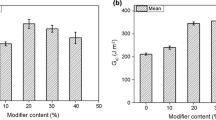Abstract
Thermosetting polymer blends composed of poly(methyl-benzene diethynylbenzene)Siliane (PSA) and cyanate ester resin (CE) were prepared via co-curing. The curing behavior and structure of the CE/PSA blends were investigated by differential scanning calorimetry and Fourier transform infrared spectroscopy, respectively. The reaction kinetic parameters were determined using Kissinger, Flynn–Wall–Ozawa and Crane methods. The thermal properties of obtained polymers were evaluated with dynamic mechanical thermal analysis and thermogravimetric analysis. The results implied that there was no reaction occurring in the blends’ preparation but a co-reaction between PSA and CE during the curing. The values of the activation energy (E a) for all the CE/PSA blends are higher than the values for CE. The thermal stability of modified resin was increased with raising PSA content, especially for CE-5 blend system, excellent thermal stability was observed and temperature at 5 wt% loss (T d5) in nitrogen was 540 °C.











Similar content being viewed by others
References
Wppster TJ, Abrol S, MacFarlane DR (2005) Rheological and mechanical properties of percolated cyanate ester nanocomposites. Polymer 46:8011–8017
Nair CPR, Mathew D, Ninan KN (2001) Cyanate ester resins, recent developments. Adv Polym Sci 155:1–99
Fink JK (2013) Reactive polymers fundamentals and applications: a concise guide to industrial polymers [M]. William Andrew
Gu A (2006) High performance bismaleimide/cyanate ester hybrid polymer networks with excellent dielectric properties. Compos Sci Technol 66:1749–1755
Hirano K, Asami M (2013) Phenolic resins—100 years of progress and their future. React Funct Polym 73:256–269
Hwang H-J, Li C-H, Wang C-S (2006) Dielectric and thermal properties of dicyclopentadiene containing bismaleimide and cyanate ester. Part IV Polym 47:1291–1299
Suman JN, Kathi J, Tammishetti S (2005) Thermoplastic modification of monomeric and partially polymerized Bisphenol A dicyanate ester. Eur Polym J 41:2963–2972
John JM, Hamerton L, Jones JR (1992) The synthesis, characterisation and thermal behaviour of functionalised aryl cyanate ester monomers. Polym Int 29:145–156
Hamerton I, Takeda S (2000) A study of the polymerization of novel cyanate ester/acrylate blends. Polymer 41:1647–1656
Chaplin A, Hamerton I, Howlin BJ, Barton JM (1994) Mechanical and properties of tough, high temperature carbon fibre composites from novel functionalized aryl cyanate ester polymers. Macromolecules 27:4927–4935
Dai Z (2006) Curing kinetics and structural changes of a of di [(N-m-acetenylphenyl) phthalimide] ether/[(methyl) diphenylacetylene] silane copolymer [J]. J Appl Polym Sci 100:2126–2130
Zhou Q (2009) Bismaleimide-modified methyl-di(phenylethynyl)silane blends and composites: cure characteristics, thermal stability, and mechanical property [J]. J Appl Polym Sci 112:3721–3727
Zhou Q (2006) Novel heat resistant methyl-tri(phenylethynyl)silane resin: synthesis, characterization and thermal properties [J]. J Appl Polym Sci 102(2):488–2492
Wang F, Zhang J, Huang J, Yan H (2006) Synthesis and characterization of poly(dimethylsilylene ethynylenephenyleneethynylene) terminated with phenylacetylene. Polym Bull 56:19–26
Itoh M, Mitsuzuka M, Iwata K et al (1994) A novel synthesis and extremely high thermal stability of poly{(phenylsilylene)-ethynlene-1,3-phenyleneethylene}. Macromolecules 27:7917–7919
Recalde IB, Recalde D, García-Lopera R, Gomez CM (2005) FTIR isothermal cure kinetics and morphology of dicyanate ester resin. Eur Polym J 41:2635–2643
Sheng X, Akinc M, Kessler MR (2008) Cure kinetics of thermosetting bisphenol E cyanate ester. J Therm Anal Calorim 93:77–85
Kissinger HE (1957) Reaction kinetics in differential thermal analysis. Anal Chem 29:1702–1706
Ozawa T (1965) A new method of analyzing thermogravimetric data. Bull Chem Soc Jpn 38:1881–1886
Andrady AL, Sefcik MD (1983) Glass transition in poly (propylene glycol) networks. J Polym Sci Polym Phys Ed 21:2453–2463
Sauer JA (1971) The influence of structure and other factors on molecular motions in solid polymers from 4 K to 300 K. J Polym Sci Part C Polym Symp 32:69–122
Cook WD (1978) An analysis of the effect of crosslinking on the Tg of polyester and other networks. Eur Polym J 14:715–720
Indrani DJ, Cook WD, Televantos F et al (1995) Fracture toughness of water-aged resin composite restorative materials. Dent Mater 11:201–207
Cook WD, Mayr AE, Edward GH (1998) Yielding behaviour in model epoxy thermosets—II. Temperature dependence. Polymer 39:3725–3733
Mustafa MF, Cook WD, Schiller TL et al (2014) Curing behavior and thermal properties of TGDDM copolymerized with a new pyridine-containing diamine and with DDM or DDS. Thermochim Acta 575:21–28
Acknowledgments
The authors are indebted to the Key Laboratory of Specially Functional Polymeric Materials and Related Technology of Ministry of Education. Finance support from the Key Project in Technology Research of Shanghai, China (Project No. 12dz1100404) is also greatly appreciated.
Author information
Authors and Affiliations
Corresponding author
Rights and permissions
About this article
Cite this article
Jiang, D., Zhou, Q., Fan, Q. et al. Curing behavior and thermal performance of cyanate ester resin modified by Poly(methyl-benzene diethynylbenzene)Siliane. Polym. Bull. 72, 2201–2214 (2015). https://doi.org/10.1007/s00289-015-1398-0
Received:
Revised:
Accepted:
Published:
Issue Date:
DOI: https://doi.org/10.1007/s00289-015-1398-0




